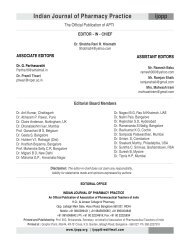Oct-Dec, 2011 - Indian Journal of Pharmacy Practice
Oct-Dec, 2011 - Indian Journal of Pharmacy Practice
Oct-Dec, 2011 - Indian Journal of Pharmacy Practice
- No tags were found...
Create successful ePaper yourself
Turn your PDF publications into a flip-book with our unique Google optimized e-Paper software.
<strong>Indian</strong> <strong>Journal</strong> <strong>of</strong> <strong>Pharmacy</strong> <strong>Practice</strong>Association <strong>of</strong> Pharmaceutical Teachers <strong>of</strong> IndiaCombating Antimicrobial Resistance: <strong>2011</strong> is the year <strong>of</strong> “No action today, No curetomorrow”1 1 2Daxesh M.P , Ganachari M.S , Sunitha C.S*1Department <strong>of</strong> <strong>Pharmacy</strong> <strong>Practice</strong>, KLE University College <strong>of</strong> <strong>Pharmacy</strong>, Belgaum, Karnataka2<strong>Pharmacy</strong> <strong>Practice</strong> and Administration, Faculty <strong>of</strong> <strong>Pharmacy</strong>, Rhodes University, Grahamstown, South AfricaA B S T R A C TSubmitted: 10/10/<strong>2011</strong>Accepted:9/11/<strong>2011</strong>The Antibiotic era, which started in the 1940s, changed human demography and the pr<strong>of</strong>ile <strong>of</strong> infectious diseases in the world. Despite theadvantages antibiotics had in improving public health across countries, continued irrational use <strong>of</strong> antimicrobials has resulted in increasinginstances <strong>of</strong> antimicrobial resistance (AMR). AMR is emerging as a global public health problem resulting in increasing morbidity, mortality andfinancial costs to treat resistant infections. AMR is causing an increased burden on the financial stability <strong>of</strong> health care systems globally, but hasthe greatest negative impact on developing countries which continue to struggle with weak infrastructures and limited resources – both humanand financial. AMR reduces the effectiveness <strong>of</strong> available, cost-effective treatments because patients remain infectious for longer and spreadresistant microorganisms to others. Developing countries, societies, families and individual patients continue to bear longer duration <strong>of</strong> illnessand treatment which increases health-care costs and their financial burden. Due to the increased incidence <strong>of</strong> resistant microorganisms in bothhospitals and community settings, the antimicrobial resistance crisis is increasing at an alarming rate and is expected to increase at a similar orhigher rate in future as antimicrobial agents continue to become ineffective. Other than irrational use <strong>of</strong> antibiotics in humans, indiscriminatemisuse <strong>of</strong> antibiotics in agriculture and animal husbandry is fuelling increased AMR. This critical juncture necessitates pr<strong>of</strong>essionalism andaccountability towards public health from pharmacists, who can play a crucial role in promoting rational use <strong>of</strong> antimicrobials and monitoring <strong>of</strong>AMR.Keywords: Antimicrobial Resistance, World Health Day, Global Problem, Role <strong>of</strong> Pharmacist, Cost and consequences, AMR ChallengesAntimicrobials and AMR ChallengesPeople live longer and healthier lives today because <strong>of</strong>powerful and effective medicines such as antimicrobialswhich are available to treat infectious diseases. Prematuredeath from various infectious diseases occurred until the1discovery and availability <strong>of</strong> antimicrobials in the 1940s.However, the introduction <strong>of</strong> every antimicrobial agent intoclinical practice has been followed by the detection <strong>of</strong> strains<strong>of</strong> microorganisms that are resistant, i.e. able to multiply inthe presence <strong>of</strong> drug concentrations higher than the2concentrations in humans receiving therapeutic doses.Antimicrobial resistance (AMR) is the resistance <strong>of</strong> amicroorganism to an antimicrobial medicine to which it waspreviously sensitive. Resistant organisms (such as bacteria,viruses and some parasites) are able to withstand attack byantimicrobial medicines, such as antibiotics, antivirals, andantimalarials, so that standard treatments become ineffective,Address for Correspondence:Sunitha C S, <strong>Pharmacy</strong> <strong>Practice</strong> and Administration, Faculty <strong>of</strong> <strong>Pharmacy</strong>,Rhodes University, Grahamstown, South AfricaE-mail: s.srinivas@ru.ac.zaand infections persist and may spread to other people. AMR isa consequence <strong>of</strong> continued misuse and irrational use <strong>of</strong>antimicrobial medicines, allowing microorganisms to mutate3or acquire a resistant gene.Some microorganisms, such as Multidrug-Resistant TB(MDR-TB), Extensively Drug Resistant TB (XDR-TB),Methicillin resistant Staphylococcus aureus, Vancomycinresistant enterococci, Streptococcus pneumoniae and otherpathogens, have developed resistance to clinically usefulantibacterial agents in both developed and developing14countries. AMR is emerging as a global public health15problem with a resulting increase in morbidity and mortality.The 60th World Health Assembly (WHA) in April 2007highlighted the serious problem <strong>of</strong> the continued overuse andinappropriate use <strong>of</strong> antibiotics worldwide based on 79216surveys in low and middle income countries. The morbidity,mortality and financial cost <strong>of</strong> antimicrobial infections posean increasing burden on the financial stability <strong>of</strong> local,regional and national health care systems globally but havethe greatest impact on developing countries with limitedresources.14, 17<strong>Indian</strong> <strong>Journal</strong> <strong>of</strong> <strong>Pharmacy</strong> <strong>Practice</strong> Volume 4 Issue 4 <strong>Oct</strong> - <strong>Dec</strong>, <strong>2011</strong> 2
















